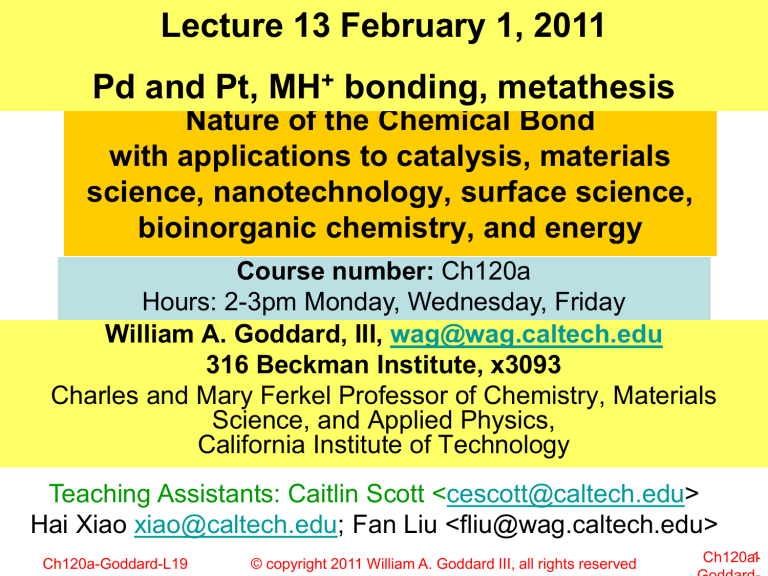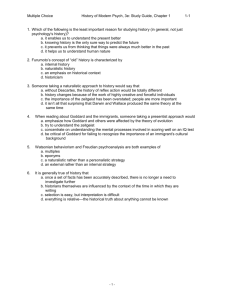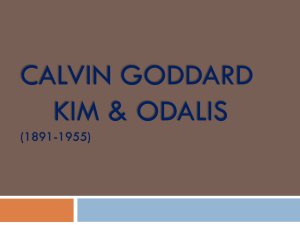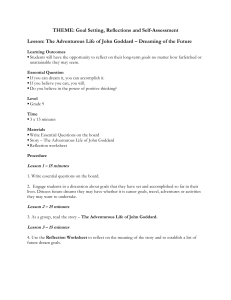Ch120-L17-13-PdPt-TM atoms-Meta-Feb22

Lecture 13 February 1, 2011
Pd and Pt, MH
+
bonding, metathesis
Nature of the Chemical Bond with applications to catalysis, materials science, nanotechnology, surface science, bioinorganic chemistry, and energy
Course number: Ch120a
Hours: 2-3pm Monday, Wednesday, Friday
William A. Goddard, III, wag@wag.caltech.edu
316 Beckman Institute, x3093
Charles and Mary Ferkel Professor of Chemistry, Materials
Science, and Applied Physics,
California Institute of Technology
Teaching Assistants: Caitlin Scott < cescott@caltech.edu
>
Hai Xiao xiao@caltech.edu
; Fan Liu <fliu@wag.caltech.edu>
Ch120a-Goddard-L19 © copyright 2011 William A. Goddard III, all rights reserved
Goddard-
Last time
Ch120a-Goddard-L19 © copyright 2011 William A. Goddard III, all rights reserved
2
Compare chemistry of column 10
Ch120a-Goddard-L19 © copyright 2011 William A. Goddard III, all rights reserved
3
Ground state of group 10 column
Pt: (5d) 9 (6s) 1 3 D ground state
Pt: (5d) 10 (6s) 0 1 S excited state at 11.0 kcal/mol
Pt: (5d) 8 (6s) 2 3 F excited state at 14.7 kcal/mol
Ni: (5d) 8 (6s) 2 3 F ground state
Ni: (5d) 9 (6s) 1 3 D excited state at
0.7 kcal/mol
Ni: (5d) 10 (6s) 0 1 S excited state at 40.0 kcal/mol
Pd: (5d) 10 (6s) 0 1 S ground state
Pd: (5d) 9 (6s) 1 3 D excited state at 21.9 kcal/mol
Pd: (5d) 8 (6s) 2 3 F excited state at 77.9 kcal/mol 4
Salient differences between Ni, Pd, Pt
2 nd
Ni Pd
Pt row (Pd): 4d much more stable than 5s Pd d 10 ground state
3 rd row (Pt): 5d and 6s comparable stability Pt d 9 s 1 ground state
4s more stable than 3d 5s much less stable than 4d 6s, 5d similar stability
3d much smaller than 4s
(No 3d Pauli orthogonality)
Huge e-e repulsion for d
Ch120a-Goddard-L19
10
Differential shielding favors n=4 over n=5, stabilize 4d over 5s d 10
Relativistic effects of 1s huge decreased KE contraction stabilize
4d similar size to 5s and contract all ns
© copyright 2011 William A. Goddard III, all rights reserved
5 destabilize and expand nd
Mysteries from experiments on oxidative addition and reductive elimination of CH and CC bonds on Pd and Pt
6
Ch120a-Goddard-L19
Step 1: examine GVB orbitals for (PH
3
)
2
Pt(CH
3
)
Ch120a-Goddard-L19 © copyright 2011 William A. Goddard III, all rights reserved
7
Analysis of GVB wavefunction
Ch120a-Goddard-L19 © copyright 2011 William A. Goddard III, all rights reserved
8
Alternative models for Pt centers
Ch120a-Goddard-L19 © copyright 2011 William A. Goddard III, all rights reserved
9
Ch120a-Goddard-L19 © copyright 2011 William A. Goddard III, all rights reserved
10
energetics
Ch120a-Goddard-L19
Not agree with
11
Possible explanation: kinetics
Ch120a-Goddard-L19 © copyright 2011 William A. Goddard III, all rights reserved
12
Consider reductive elimination of HH,
CH and CC from Pd
Conclusion:
HH no barrier
CH modest barrier
CC large barrier
Ch120a-Goddard-L19 © copyright 2011 William A. Goddard III, all rights reserved
13
Consider oxidative addition of
HH, CH, and CC to Pt
Ch120a-Goddard-L19
Conclusion:
HH no barrier
CH modest barrier
14
Summary of barriers
This explains why CC coupling not occur for Pt while CH and HHcoupling is fast
But why?
Ch120a-Goddard-L19 © copyright 2011 William A. Goddard III, all rights reserved
15
How estimate the size of barriers (without calculations)
Ch120a-Goddard-L19 © copyright 2011 William A. Goddard III, all rights reserved
16
Examine HH coupling at transition state
Can simultaneously get good overlap of H with Pd sd hybrid and with the other H
Thus get resonance stabilization of TS low barrier
Ch120a-Goddard-L19 © copyright 2011 William A. Goddard III, all rights reserved
17
Examine CC coupling at transition state
Can orient the CH
3 can orient the CH
3 to obtain good overlap with Pd sd hybrid OR to obtain get good overlap with the other CH
3
But CANNOT DO BOTH SIMULTANEOUSLY, thus do NOT get resonance stabilization of TS high barier 18
Examine CH coupling at transition state
Ch120a-Goddard-L19
H can overlap both CH
3 and Pd sd hybrid simultaneously but CH
3 cannot thus get ~ ½ resonance stabilization of TS
© copyright 2011 William A. Goddard III, all rights reserved
19
Now we understand Pt chemistry
But what about Pd?
Why are Pt and Pd so dramatically different
Ch120a-Goddard-L19 © copyright 2011 William A. Goddard III, all rights reserved
20
new
Ch120a-Goddard-L19 © copyright 2011 William A. Goddard III, all rights reserved
21
Pt goes from s 1 d 9 to d 10 upon reductive elimination thus product stability is DECREASED by 12 kcal/mol
Using numbers from QM
Ch120a-Goddard-L19 © copyright 2011 William A. Goddard III, all rights reserved
22
Ground state configurations for column 10
Ni Pd Pt
Ch120a-Goddard-L19 © copyright 2011 William A. Goddard III, all rights reserved
23
Pd goes from s 1 d 9 to d 10 upon reductive elimination thus product stability is INCREASED by 20 kcal/mol
Using numbers from QM
Pd and Pt would be ~ same
Ch120a-Goddard-L19 © copyright 2011 William A. Goddard III, all rights reserved
24
Thus reductive elimination from Pd is stabilized by an extra 32 kcal/mol than for Pt due to the ATOMIC nature of the states
The dramatic stabilization of the product by 35 kcal/mol reduces the barrier from ~ 41 (Pt) to ~ 10 (Pd)
This converts a forbidden reaction to allowed
Ch120a-Goddard-L19 © copyright 2011 William A. Goddard III, all rights reserved
25
Summary energetics
Conclusion the atomic character of the metal can control the chemistry
Ch120a-Goddard-L19 © copyright 2011 William A. Goddard III, all rights reserved
26
Examine bonding to all three rows of transition metals
Use MH+ as model because a positive metal is more representative of organometallic and inorganic complexes
M0 usually has two electrons in ns orbitals or else one
M+ generally has one electron in ns orbitals or else zero
M2+ never has electrons in ns orbitals
Ch120a-Goddard-L19 © copyright 2011 William A. Goddard III, all rights reserved
27
Ground states of neutral atoms
Fe
Co
Ni
Cu
Sc
Ti
V
Cr
Mn
(4s)2(3d)
(4s)2(3d)2
(4s)2(3d)3
(4s)1(3d)5
(4s)2(3d)5
(4s)2(3d)6
(4s)2(3d)7
(4s)2(3d)8
(4s)1(3d)10
Sc + (4s)1(3d)1
Ti +
V +
(4s)1(3d)2
(4s)0(3d)3
Cr + (4s)0(3d)5
Mn + (4s)1(3d)5
Fe + (4s)1(3d)6
Co + (4s)0(3d)7
Ni + (4s)0(3d)8
Cu + (4s)0(3d)10
Sc ++ (3d)1
Ti ++ (3d)2
V ++ (3d)3
Cr ++ (3d)4
Mn ++ (3d)5
Fe ++ (3d)6
Co ++ (3d)7
Ni ++ (3d)8
Cu ++ (3d)10
Ch120a-Goddard-L19 © copyright 2011 William A. Goddard III, all rights reserved
28
Bond energies MH+
Mo
Re
Cr
Au
Cu
Ch120a-Goddard-L19
Ag
© copyright 2011 William A. Goddard III, all rights reserved
29
Exchange energies:
Mn+: s 1 d 5
For high spin (S=3)
A
[(d
1 a
)(d
2 a
)(d
3 a
)(d
4 a
)(d
5 a
)(s a
)]
Get 6*5/2=15 exchange terms
5Ksd + 10 Kdd
Responsible for Hund’s rule
Ksd Kdd
Mn+ 4.8
19.8 kcal/mol
Tc+ 8.3
15.3
Re+ 11.9
14.1
Form bond to H, must lose half the exchange stabilization for the orbital bonded to the H
A
{(d
1 a
)(d
2 a
)(d
3 a
)(d
4 a
)(sd b a
)[(sd b
)H+H(sd b
)]( ab-ba
)} sd b is a half the time and
Ch120a-Goddard-L19 b half the time
© copyright 2011 William A. Goddard III, all rights reserved
30
Ground state of M + metals
Mostly s1dn-1
Exceptions:
1 st row: V, Cr-Cu
2 nd row: Nb-Mo, Ru-Ag
3 rd row: La, Pt, Au
Ch120a-Goddard-L19 © copyright 2011 William A. Goddard III, all rights reserved
31
Size of atomic orbitals, M +
Valence s similar for all three rows,
5s biggest
Big decrease from
La(an 57) to Hf(an 72
Valence d very small for 3d
Ch120a-Goddard-L19 © copyright 2011 William A. Goddard III, all rights reserved
32
Charge transfer in MH + bonds electropositive
1 st row all electropositive
2 nd row:
Ru,Rh,Pd electronegative
3 rd row:
Pt, Au, Hg electronegative
Ch120a-Goddard-L19 electronegative
© copyright 2011 William A. Goddard III, all rights reserved
33
Ch120a-Goddard-L19 © copyright 2011 William A. Goddard III, all rights reserved
34
Ch120a-Goddard-L19 © copyright 2011 William A. Goddard III, all rights reserved
35
Ch120a-Goddard-L19 © copyright 2011 William A. Goddard III, all rights reserved
36
Ch120a-Goddard-L19 © copyright 2011 William A. Goddard III, all rights reserved
37
1 st row
Ch120a-Goddard-L19 © copyright 2011 William A. Goddard III, all rights reserved
38
Ch120a-Goddard-L19 © copyright 2011 William A. Goddard III, all rights reserved
39
Schilling
Ch120a-Goddard-L19 © copyright 2011 William A. Goddard III, all rights reserved
40
Steigerwald
Ch120a-Goddard-L19 © copyright 2011 William A. Goddard III, all rights reserved
41
Ch120a-Goddard-L19 © copyright 2011 William A. Goddard III, all rights reserved
42
Ch120a-Goddard-L19 © copyright 2011 William A. Goddard III, all rights reserved
43
2 nd row
Ch120a-Goddard-L19 © copyright 2011 William A. Goddard III, all rights reserved
44
Ch120a-Goddard-L19 © copyright 2011 William A. Goddard III, all rights reserved
45
Ch120a-Goddard-L19 © copyright 2011 William A. Goddard III, all rights reserved
46
Ch120a-Goddard-L19 © copyright 2011 William A. Goddard III, all rights reserved
47
Ch120a-Goddard-L19 © copyright 2011 William A. Goddard III, all rights reserved
48
Ch120a-Goddard-L19 © copyright 2011 William A. Goddard III, all rights reserved
49
Ch120a-Goddard-L19 © copyright 2011 William A. Goddard III, all rights reserved
50
3 rd row
Ch120a-Goddard-L19 © copyright 2011 William A. Goddard III, all rights reserved
51
Ch120a-Goddard-L19 © copyright 2011 William A. Goddard III, all rights reserved
52
Ch120a-Goddard-L19 © copyright 2011 William A. Goddard III, all rights reserved
53
Ch120a-Goddard-L19 © copyright 2011 William A. Goddard III, all rights reserved
54
Ch120a-Goddard-L19 © copyright 2011 William A. Goddard III, all rights reserved
55
Ch120a-Goddard-L19 © copyright 2011 William A. Goddard III, all rights reserved
56
Ch120a-Goddard-L19 © copyright 2011 William A. Goddard III, all rights reserved
57
Ch120a-Goddard-L19 © copyright 2011 William A. Goddard III, all rights reserved
58
Ch120a-Goddard-L19 © copyright 2011 William A. Goddard III, all rights reserved
59
Ch120a-Goddard-L19 © copyright 2011 William A. Goddard III, all rights reserved
60
Ch120a-Goddard-L19 © copyright 2011 William A. Goddard III, all rights reserved
61
Ch120a-Goddard-L19 © copyright 2011 William A. Goddard III, all rights reserved
62
Ch120a-Goddard-L19 © copyright 2011 William A. Goddard III, all rights reserved
63
Physics behind Woodward-Hoffman Rules
For a reaction to be allowed, the number of bonds must be conserved. Consider H
2
+ D
2
2 bonds TS ? bonds 2 bonds
To be allowed must have 2 bonds at TS
How assess number of bonds at the TS. What do the dots mean? Consider first the fragment
Have 3 electrons, 3 MO’s
Have 1 bond. Next consider 4 th atom, can we get 2 bonds?
Ch120a-Goddard-L19
Bonding nonbonding antibonding
0 elect 64
Can we have 2s + 2s reactions for transition metals?
2s + 2s forbidden for organics
X
Cl
2
Ti
2s + 2s forbidden for organometallics?
?
Cl
2
Ti ?
Cl
2
Ti
Cl
2
Ti Me Cl
2
Ti Me
Cl
2
Ti Me
65
Physics behind Woodward-Hoffman Rules
Bonding
2 elect nonbonding
1 elect antibonding
0 elect
Have 1 bond. Question, when add 4 th atom, can we get 2 bonds?
Can it bond to the nonbonding orbital?
Answer: NO. The two orbitals are orthogonal in the TS, thus the reaction is forbidden
Ch120a-Goddard-L19 © copyright 2011 William A. Goddard III, all rights reserved
66
Now consider a TM case: Cl
2
TiH + + D
2
Orbitals of reactants
GVB orbitals of TiH bond for Cl
2
TiH +
GVB orbitals of D
2
Ch120a-Goddard-L19 © copyright 2011 William A. Goddard III, all rights reserved
67
Is Cl
2
TiH + + D
2
Cl
2
TiD + + HD allowed?
Bonding
2 elect nonbonding
1 elect antibonding
0 elect when add Ti 4 th atom, can we get 2 bonds?
Now the bonding orbital on Ti is d-like. Thus at TS have
Answer: YES. The two orbitals can have high overlap at the TS orthogonal in the TS, thus the reaction is allowed
Ch120a-Goddard-L19 © copyright 2011 William A. Goddard III, all rights reserved
68
GVB orbitals at the TS for
Cl
2
TiH + + D
2
Cl
2
TiD + + HD
Ch120a-Goddard-L19 © copyright 2011 William A. Goddard III, all rights reserved
69
GVB orbitals for the Cl
2
TiD + + HD product
Note get phase change for both orbitals
Ch120a-Goddard-L19 © copyright 2011 William A. Goddard III, all rights reserved
70
Follow the D2 bond as it evolves into the
HD bond
Ch120a-Goddard-L19 © copyright 2011 William A. Goddard III, all rights reserved
71
Follow the TiH bond as it evolves into the
TiD bond
Ch120a-Goddard-L19 © copyright 2011 William A. Goddard III, all rights reserved
72
Barriers small, thus allowed
Increased d character in bond smaller barrier
Ch120a-Goddard-L19 © copyright 2011 William A. Goddard III, all rights reserved
73
Are all MH reactions with D2 allowed? No
Example: ClMn-H + D2
Here the Mn-Cl bond is very polar
Mn(4s-4p z
) lobe orbital with Cl:3pz
This leaves the Mn: (3d) 5 (4s+4pz), S=3 state to bond to the H
But spin pairing to a d orbital would lose
4*K dd
/2+K sd
/2= (40+2.5) = 42.5 kcal/mol whereas bonding to the (4s+4pz) orbital loses
5*K sd
/2 = 12.5 kcal/mol
As a result the H bonds to (4s+4pz), leaving a high spin d5.
Now the exchange reaction is forbidden
Ch120a-Goddard-L19 © copyright 2011 William A. Goddard III, all rights reserved
74
Thus ClMn-H bond is sp-like
ClMnH
Mn (4s) 2 (3d) 5
The Cl pulls off 1 e from
Mn, leaving a d 5 s 1 configuration
H bonds to 4s because of exchange stabilization of d 5
Mn-H bond character
0.07 Mnd+0.71Mnsp+1.20H
This cannot overlap the antisymmetric orbital delocalized over the three H atoms in the TS
As a result at the Transition state the MnH bond has the character of H
3
with both electrons on the H3.
This leads to a high barrier, ~45 kcal/mol
Ch120a-Goddard-L19 © copyright 2011 William A. Goddard III, all rights reserved
Show reaction for ClMnH + D2
Show example reactions
Ch120a-Goddard-L19 © copyright 2011 William A. Goddard III, all rights reserved
76
Olefin Metathesis
2+2 metal-carbocycle reactions
Diego Benitez, Ekaterina Tkatchouk, Sheng Ding
Ch120a-Goddard-L21 © copyright 2010 William A. Goddard III, all rights reserved
77
OLEFIN METATHESIS
Catalytically make and break double bonds!
R
1
R
1
+
R
2
R
2
2
R
1
Mechanism: actual catalyst is a metal-alkylidene
R
2
R
2
R
2
M
M M
R
2
R
1
R
3
R
1
R
3
R
1
R
3
Ch120a-Goddard-L21 © copyright 2010 William A. Goddard III, all rights reserved
78
Ru Olefin Metathesis Basics
Ch120a-Goddard-L21 © copyright 2010 William A. Goddard III, all rights reserved
79
Common Olefin Metathesis Catalysts
Ch120a-Goddard-L21 © copyright 2010 William A. Goddard III, all rights reserved
80
Applications of the olefin metathesis reaction
Ch120a-Goddard-L21 bulletproof resin
Small scale synthesis to industrial polymers
Acc. Chem. Res. 2001, 34 , 18-29
81
History of Olefin Metathesis Catalysts
Ch120a-Goddard-L21 © copyright 2010 William A. Goddard III, all rights reserved
82
Well-defined metathesis catalysts
R R
R R i Pr
N
(F
3
C)
2
MeCO
(F
3
C)
2
MeCO
Mo
1
Schrock 1991 alkoxy imido molybdenum complex a
Bazan, G. C.; Oskam, J. H.;
Cho, H. N.; Park, L. Y.;
Schrock, R. R. J. Am.
Chem. Soc. 1991, 113 ,
6899-6907 i Pr
Ph
CH
3
CH
3
Cl
PCy
3 Ph
Ru
Cl
PCy
3
Mes N
Cl
Ru
Cl
N
PCy
3
Mes
Ph
R=H, Cl
3
Grubbs 1999
1,3-dimesityl-imidazole-2-ylidenes
P(Cy)
3 mixed ligand system” c complex b
2
Grubbs 1991 ruthenium benzylidene
Wagener, K. B.;
Boncella, J. M.; Nel,
J. G. Macromolecules
1991 , 24 , 2649-2657
Scholl, M.; Trnka, T. M.; Morgan,
J. P.; Grubbs, R. H. Tetrahedron
Lett. 1999, 40 , 2247-2250.
Mes N
Cl
Ru
Cl
N
PCy
3
Mes
Ph
R=H, Ph,
or -CH
2
-(CH
2
)
2
-CH
2
-
4
GODDARD Ch120-L20 13/11/02
83
Metathesis Catalysts and Mechanism Overview
Mes
Cl
N
Ru
N
Cl
Mes
Ph
PCy
3
Mes
N
Ru
N
Cl
Mes
Cl
i-Pr
O
Mes
Cl
N
Ru
N
Cl
Mes
Ph
Py slow initiating catalyst fast-initiating catalyst ultra-fast-initiating catalyst
General mechanism of Metathesis
IMes
Cl
Ru
IMes
Cl
Ru Initiation
Cl Ph
L
L Cl R
Cl
IMes
Cl
Ru
R
1
Ch120a-Goddard-L21
R
3
R
2
Cl
R
3
IMes
Cl
R
Ru
R
2
Cl
IMes
Cl
Ru
R
3
Propagation
+
R
1
© copyright 2010 William A. Goddard III, all rights reserved
R
2
84
Schrock and Grubbs catalysts make olefin metathesis practical
Schrock catalyst – very active, but destroys many functional groups
Grubbs catalyst – very stable, high functional group tolerance, but not as reactive as Schrock
Catalysts contain many years of evolutionary improvements
Ch120a-Goddard-L21 © copyright 2010 William A. Goddard III, all rights reserved
85






